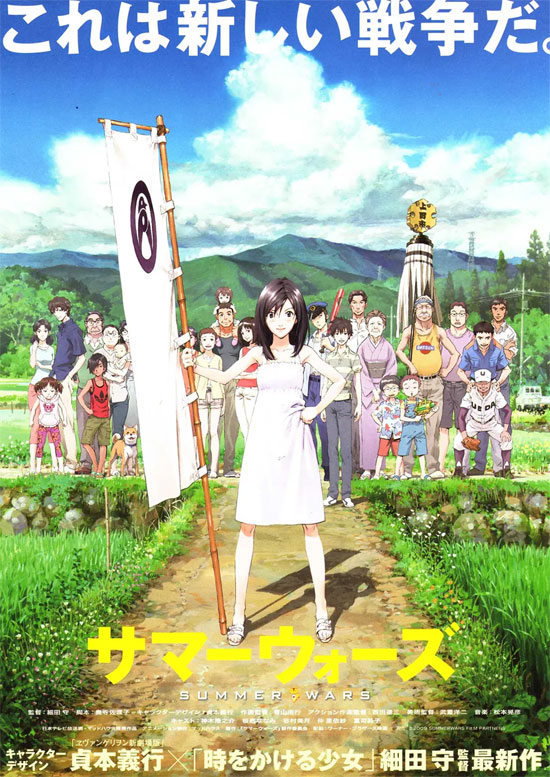Film Name: 夏日大作战 / Summer Wars / サマーウォーズ

Some people are alive, yet they are already dead. Some people are dead, yet they still live on…
Though “Summer Wars” and Zang Kejia’s “The Living and the Dead” share nothing in common, after watching this anime, I was deeply moved by the bond between the departed flesh and the spirit that endures forever.
Human beings exist to carry forward a certain spirit.
Truthfully, I never expected the kind, capable grandmother of the Jinnai family to pass away. Her death serves as a pivotal plot twist in this animation and stands as the most crucial element elevating it in my heart.
First, regarding the plot. It was precisely the death of the grandmother—the matriarch of this family descended from Sengoku warriors—that imbued the mechanistic elements represented by AI virtual characters with an evil connotation, thereby laying the ethical groundwork for the righteousness of the “Great Operation.” It is precisely the grandmother—the source of the family’s cohesion and its pillar—whose passing leaves the Arima family momentarily adrift, leading them to realize that carrying on her spirit is the true essence of rebuilding their familial bonds; It was precisely the passing of the grandmother—who genuinely loved Wabisuke and earnestly wished for his return to the family and acceptance by its members—that brought Wabisuke, who similarly yearned to prove himself and return home, back into the family fold. This was not merely a physical return, but a spiritual one.
The most bittersweet realization is this: though both Grandma and Wajū longed to accept each other, Wajū never truly returned while she lived. Only after her passing could he fulfill this lifelong wish. Similarly, the family rejected Wajū during her lifetime, yet embraced him after her death. Everyone attained a happiness tinged with regret.
Now, my personal reflection. Grandma’s passing made me realize that it was precisely her death that gave her descendants meaning in life—to carry forward this family cohesion, this spirit of selfless dedication and service, this embrace of tolerance and universal love. While her death appears sorrowful on the surface, for her it was perhaps a form of happiness, for the value of her life was fulfilled.
Indeed, the film’s final shot—revealing the grandmother’s portrait smiling radiantly as the family unites to overcome adversity—is neither superfluous nor a mere stroke of genius. It is the most crucial frame of the entire film! If you set aside the film’s novel surrealism, its tense battle sequences and dazzling choreography, its parallel montages of baseball games and real combat, and all its surface-level technical brilliance—what remains is the deepest, most profound element: the essence of humanity. And that is embodied in the grandmother’s final, blissful smile.
This smile reveals the film’s core theme: Was this summer battle truly against a virtual virus? No—it was a battle within the family, a struggle against grief, fear, confusion, and dissent. The key to overcoming it all lay in inheriting Grandma’s spirit.
This animation stirred many memories of life in Japan. When I see some reviews interpreting elements like morning glories as cinematic language, I wouldn’t say they’re wrong—it’s certainly true. But what these subtle symbols of daily life evoke in me is my deepest nostalgia for Japanese living: the spirit of craftsmanship.
Regardless of a family’s wealth, Japanese people always keep their gardens meticulously tended, planting various flowers and plants with careful attention. At the family gathering for Natsuki and Kenji, everyone toasts each other in warm camaraderie, meticulously nurturing their bonds. In OZ’s virtual world, every detail is perfected to the utmost—a craftsmanship the Japanese carry from daily life into their work. Even beyond the film, director Mamoru Hosoda’s masterful, meticulous handling of the entire story earns sincere admiration.
Recalling the “dependence complex” described by Japanese psychologist Tsuchii Kenro in The Psychological Structure of the Japanese, this animated film is saturated with the deep affection of mutual reliance and trust within the family. The Jinnai family, including Grandma, carries forward the responsibility and honor of a samurai household from Japan’s Warring States period, embodying a “dependence” complex toward their ancestors. Before and after Grandma’s passing, every member of the Jinnai family—young and old, male and female—exhibited profound respect and dependence on this matriarch. Yet dependence comes in two forms: passive and active. Passive dependence becomes a burden, while active dependence can become a driving force. The Jinnai family’s reliance on Grandma was an active form of dependence, rooted in their shared conviction to carry forward her spirit through their actions.
For a film that sparked my imagination, offered enlightenment, and moved me so deeply, I don’t know how to repay it. All I can do is give it a high rating and write this review to recommend it. (I gave the animation a perfect 10 for its story.) Heh.
Finally, I pose this question to everyone—and equally to myself: What spirit are you passing on? Is there a spirit you wish to impart to future generations?
PS: One rather amusing aspect of the film is this: A student who couldn’t make the Japanese Math Olympiad team somehow manages to crack an incredibly complex code in just two hours. That’s a bit presumptuous, isn’t it? Heh.
Please specify:Anime Phone Cases » Summer Wars 2009 Animation Film Review: Some people die, yet they live on.